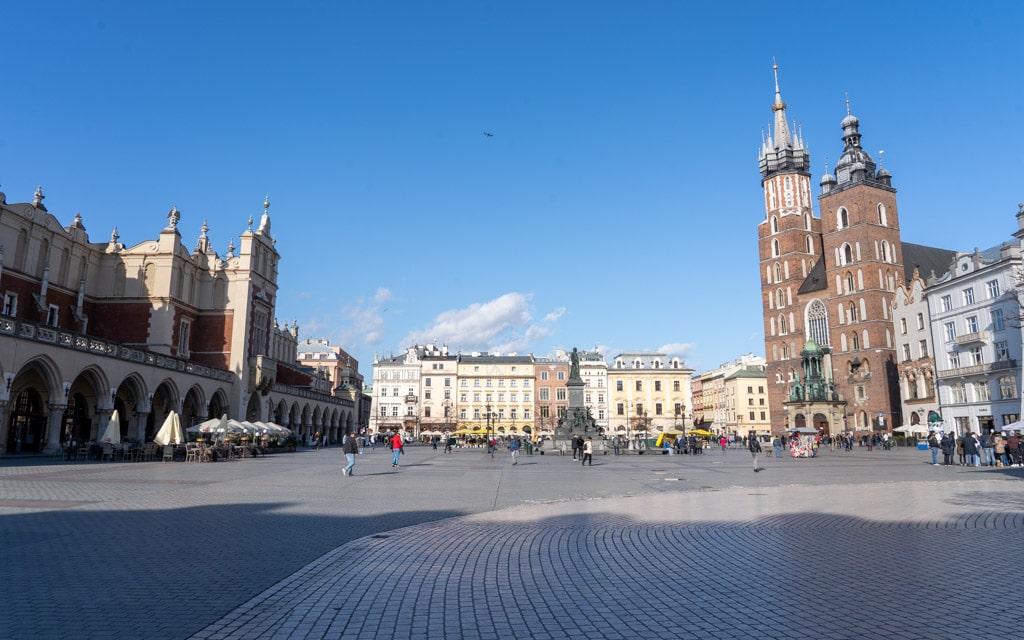
If you only have one day in Kraków, one of the best ways to enjoy the city is by taking a tour of Kraków’s Old Town and Royal Road.
When Kraków was the royal capital of Poland from the 14th to 16th centuries, this historic street was the site of many important events, including coronation processions, royal funerals, weddings, and foreign envoys.
The route runs from the old Medieval walls near St. Florian’s Gate in the north through the Old Town and finally to Wawel Cathedral in the south.
Walking along the Royal Road is the perfect way to see most of Kraków’s must-see sights, making it ideal for those with only 24 hours in Kraków.
Table of Contents
1 – Planty

By the early 19th century, the old defensive walls surrounding the city were in disrepair as Kraków began to expand and modernize.
Emperor Franz I of Austro-Hungary ordered the dismantling of medieval city walls, the removal of the towers, and the filling of the moats. Fortunately, the Barbican and Florian’s Gate spared destruction.
Gardens, fountains, walkways, and statues replaced the defensive walls during an urban development project.
Today, this green belt is known as the Planty, a 4 kilometer (2.5 mile) park that encircles the entire Old Town of Kraków. Planty comes from the Polish word plantovac, which means “flat.”
If you have the time, a great way to enjoy Kraków is to walk the entire park, which circles the Old Town.
This pleasant walk, which takes at least two hours to appreciate fully, will take you through some of the quieter parts of Kraków.
While some tourists will carry guidebooks and cameras, you will more likely encounter street musicians, locals walking their dogs, and couples holding hands.
2 – Kraków Barbican and the Old City Walls

The imposing Kraków Barbican (Barbakan Krakowski) is located just north of Old Town (Stare Miasto).
This round-fortified defensive outpost provided extra security along the city walls and protected weaker points along the wall, such as where there were gates.
This Barbican is one of only three remaining defensive outposts in Europe, and Kraków Barbican is the best preserved.
The Kraków Barbican, built in a Gothic style, dates back to the end of the 15th century.
The red brick and stone tower has a diameter of 25 meters (82 feet) with walls that are 3 meters (9.8 feet) wide at its base and 0.5 meters (1.6 feet) wide at the top.
Its walls feature 130 narrow defensive slots known as embrasures, which archers or gunners use to attack invaders.
3 – Grunwald Monument
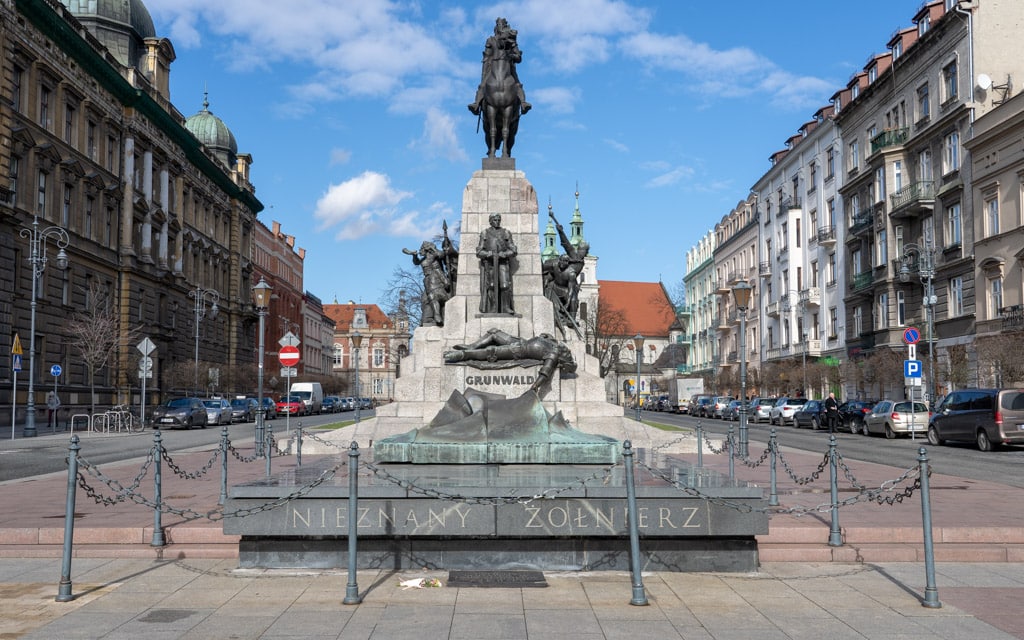
The Grunwald Monument (Pomnik Grunwaldzki) is an equestrian statue monument located in the center of Matejko Square just north of the Barbican.
Matejko Square honors the 500th anniversary of the Battle of Grunwald.
The Battle of Grunwald, which occurred on July 15, 1410, was one of the most important battles in Poland’s history.
During the battle, soldiers from Poland and Lithuania fought to defeat the Teutonic Knights, a group of German crusaders brought to Poland as mercenaries.
Two Polish sculptors, Antoni Wiwulski and Franciszek Black, designed the bronze and granite Grunwald Monument. The sculpture debuted on July 15, 1910, 500 years after the Battle of Grunwald.
During World War II, German soldiers destroyed the monument. It was not until 1976 that it was reconstructed based on its original plans.
The Grunwald Monument is 24 meters (78.7 feet) tall. At the top is an equestrian statue of King Władysław Jagiełło, the King of Poland from 1377 to 1381. The king holds a bridle in his left hand and his sword in his right.
Standing just below the king is a statue of Vytautas the Great, the Grand Duke of Lithuania.
Just below Vytautas is a statue depicting a slain Ulrich von Jungingen, the Grand Master of the Teutonic Knights. At the back of the monument is a statue of a peasant removing his shackles.
On the left side, a Lithuanian warrior blows a horn while walking with a captured Teutonic knight. On the right side, a Polish knight and a page collect Teutonic banners.
4 – St. Florian’s Gate (Brama Floriańska)

This impressive rectangular gate, named after Saint Florian, is known as St. Florian’s Gate (Brama Floriańska).
It is one of Poland’s most notable and iconic Gothic towers and an important cultural icon of Kraków’s Old Town. The tower measures in at 33.5 meters (109.9 feet) tall.
St. Florian’s Gate, built in 1307, was part of the new city defenses that surrounded Kraków. At its height, the city wall featured 17 towers, 47 watchtowers, and eight gates, including this one.
The gate was the main entryway into the Old Town. Those wishing to enter the Old Town would first have to pass through the Barbican, walk across a drawbridge over the town moat, and finally pass through St. Florian’s Gate.
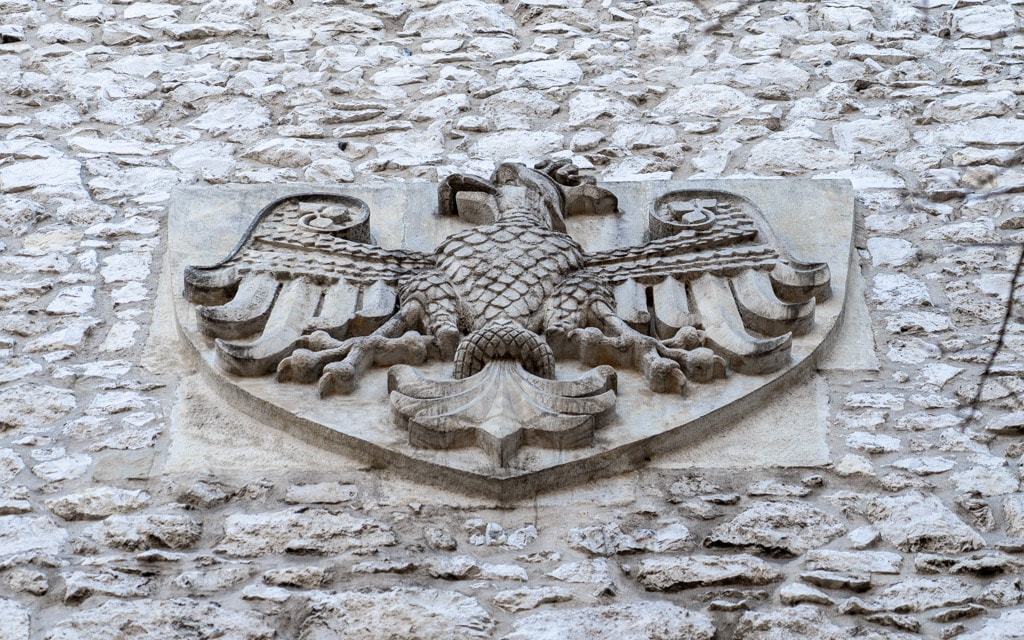
Stand in front of the gate on its northern side and look halfway up the tower. You will find a crowned white eagle here.
This eagle, a historic symbol of Poland, represents the courage and freedom of the Poles.
Inside the gate is a small chapel with a replica of Black Madonna of Częstochowa (Czarna Madonna or Matka Boska Częstochowska), the “Queen Protector of Poland.”
Polish Catholics consider this to be their most important religious symbol. The original statue is 112 kilometers (70 miles) to the north in Czestochowa.
About halfway up the tower, on its southern side, is a statue of Saint Florian, the patron saint of Poland since 1184.
He is also the patron saint of the fire brigade, as fire was a big concern in medieval Kraków due to wooden buildings.
5 – Floriańska Street (Ulica Floriańska)
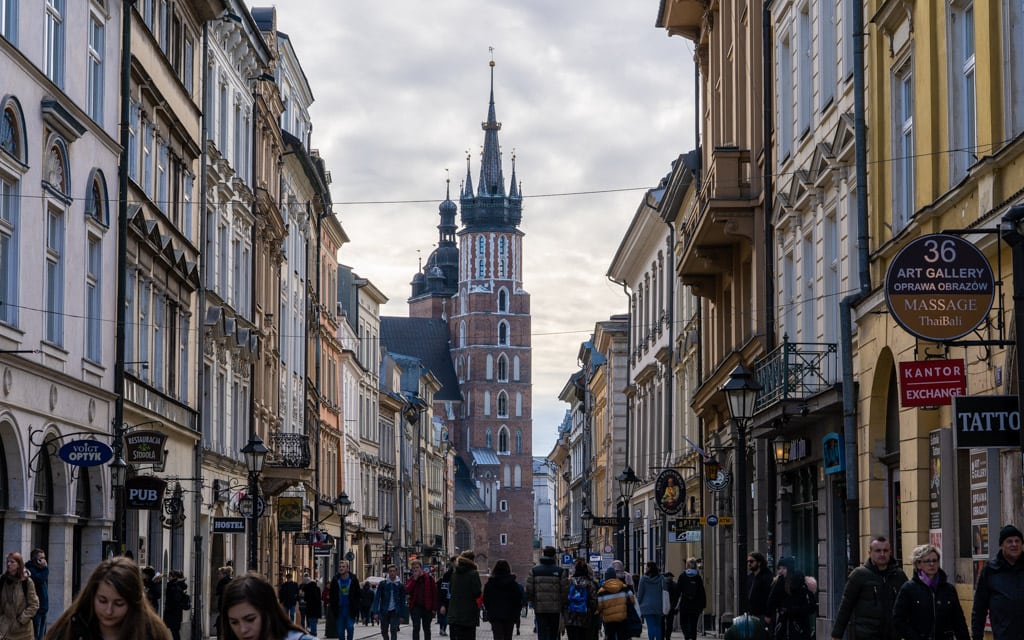
One of the most famous streets in Old Town Kraków is Floriańska Street (Ulica Floriańska) or St. Florian’s Street.
Floriańska Street, which dates back to 1257, runs 335 meters (1,099 feet) from St. Florian’s Gate to Main Market Square.
There are currently 51 numbered buildings lining Floriańska Street.
Here, you will find an odd mix of historic Kamienica-style buildings (brick or stone residential buildings), international fast-food chains, shops, restaurants, hotels, and museums.
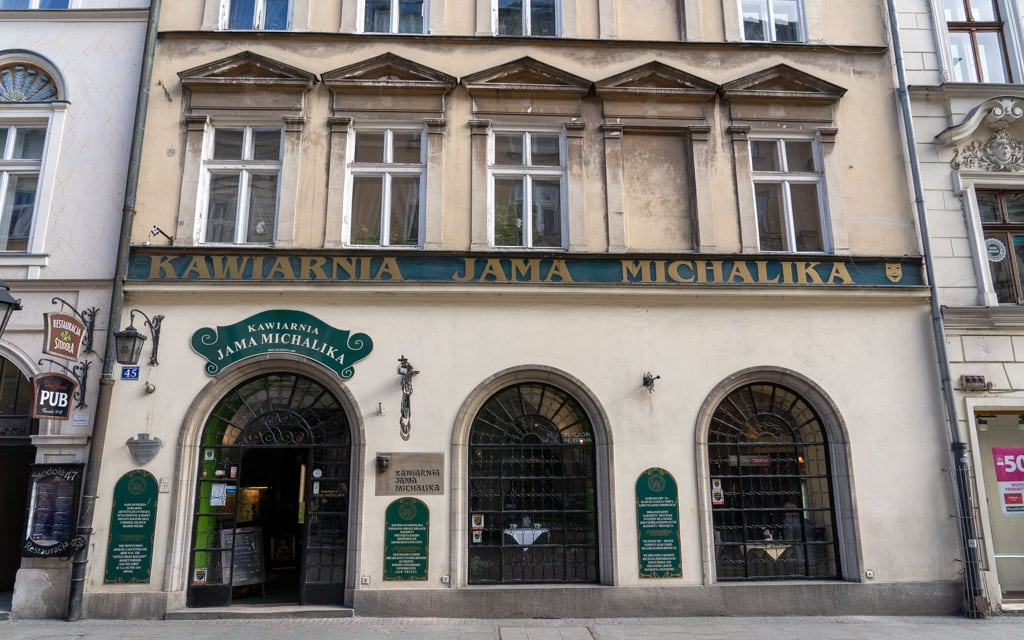
At #45 is Kawiarnia Jama Michalika (Jama Michalika Cafe). At the turn of the 20th century, this dark cafe was a local hangout of the Młoda Polska (Young Poland) movement, which popularized Art Nouveau in Poland.
A block further at #20 is Staropolskie Trunki, one of the best local spots to sample affordable Polish vodka and mulled wine.
While the amount of local vodkas and liquors behind the bar can be overwhelming for first-time visitors to Poland, the friendly and knowledgeable lady behind the bar will explain everything to help you find that perfect drink.
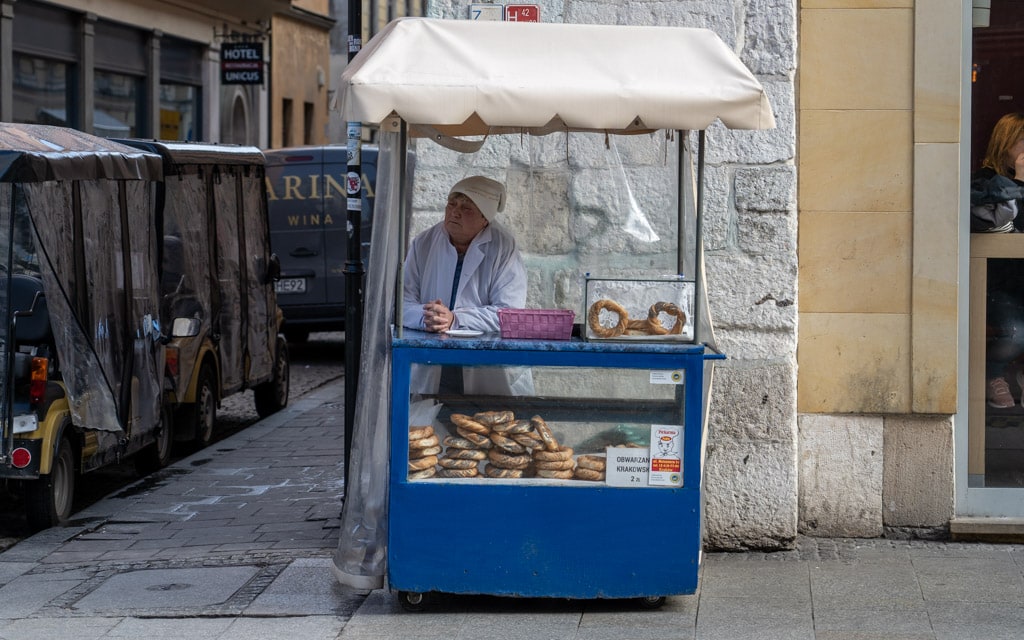
Hungry? Well, then, you are in luck. You can find it all here, from Polish restaurants to international fast-food chains to pizza shops and kebab windows.
Some shops sell zapiekanka, an open-face sandwich topped with various ingredients. I think of it as a Polish-French pizza.
Another local specialty is obwarzanek krakowski, a boiled and baked ring-shaped golden brown bread crunchy on top while the inside is moist.
The old-fashioned blue carts selling fresh obwarzanek krakowski are easy to spot on Floriańska Street.
6 – Main Market Square (Rynek Główny)
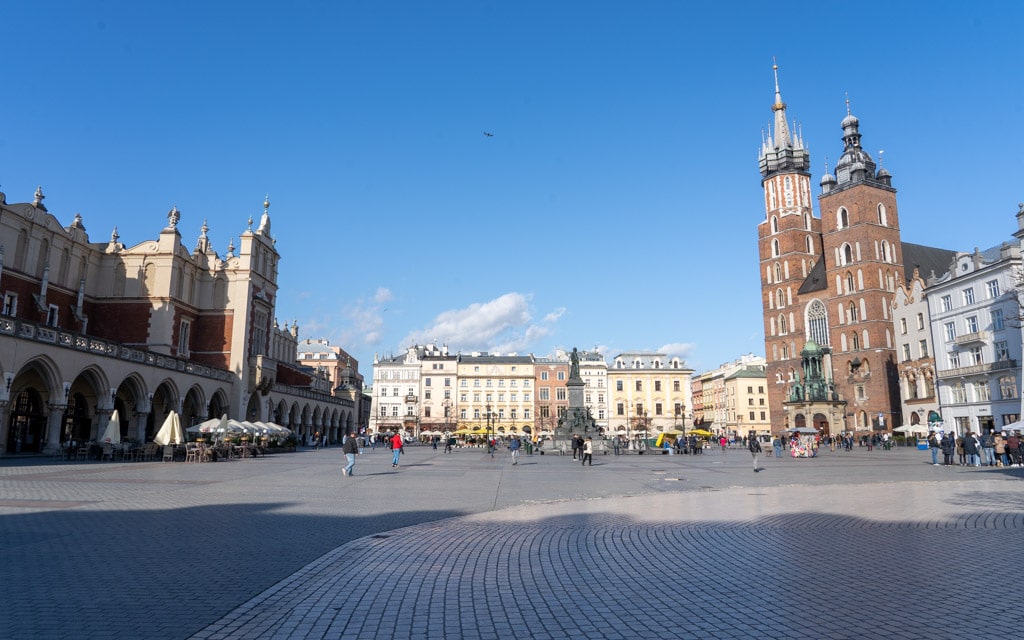
This is one of the world’s most magnificent squares, Main Market Square (Rynek Główny), the heart of Kraków since the 13th century.
The square is Europe’s largest medieval town square at 40,000 square meters (430,556 square feet).
Main Market Square has changed little over the centuries. Here you will find townhouses, churches, and restaurants. St. Mary’s Basilica, the Cloth Hall, and the Town Hall Tower dominate the square.
Over the centuries, the square has been the site for special events, markets, celebrations, festivals, and executions.
During World War II, much of Kraków, including the square, was saved from destruction. Kraków, with its Germanic roots, was considered a sacred city.
While the Germans destroyed any symbol of Polish culture, they decided to save the city from destruction.
In between St. Mary’s Basilica and the Cloth Hall is a modern fountain and glass pyramid.
The Rynek Underground Museum, located beneath this spot, opened in September 2010 after a major excavation.
Visitors to this popular museum can learn the complete history of Kraków from its first inhabitants until the death of Pope John Paul II.
Not far from the fountain, in the middle of the square in front of the Cloth Hall, is a statue of Adam Mickiewicz.
Mickiewicz (1798-1855) is one of Poland’s greatest poets. He is best known for Dziady (Forefathers’ Eve) and Pan Tadeusz, considered among the greatest works of Polish literature. He lies buried in Wawel Cathedral.

If you are in the mood for a drink, stop by one of the restaurants or cafes lining the square, where you can try Polish beer, vodka, or coffee. You can’t beat the views.
And the prices are very affordable for the location compared to other European cities.
7 – St. Mary’s Basilica (Kościół Mariacki)

One of Poland’s most iconic sights is St. Mary’s Basilica (Kościół Mariacki), with its two towers, is located on the Main Market Square in the heart of Old Town Kraków.
Technically, St. Mary’s Basilica only has one tower. The shorter tower on the right is part of the church. The taller tower on the left is a watchtower.
A church has stood on this spot since the early 13th century. The original St. Mary’s Basilica was founded here around 1220. Destruction of the church happened during the Tatar invasion of Poland in 1241.
The Gothic church, as seen today, was rebuilt on its foundations starting around the 14th century. The church was consecrated in 1320.
According to legend, during the Tatar invasion, a soldier standing guard inside the watchtower alerted the city of the invading Mongols by playing his trumpet.
Before the sentry could finish his tune, he was shot in the throat by an arrow.
Today, a trumpeter plays the same tune, Hejnał Mariacki or St. Mary’s Trumpet Call, from the same tower every hour. The national Polish radio even broadcasts the noon performance.
8 – Cloth Hall (Sukiennice)

Located at the center of Kraków’s main square is the iconic Cloth Hall (Sukiennice), which has been a UNESCO World Heritage Site since 1978.
A trading hall has been located here since the 13th century during the Middle Ages, making it one of the oldest shopping halls in the world. During this period, cloth sellers would meet here to sell their goods.
In the 14th century, Kazimierz the Great turned the hall into a permanent structure. During the golden age of the 15th century, merchants sold not only cloth but exotic imports from the East, including spices, silk, and leather.
A fire destroyed the market hall in 1555. Not long after, reconstruction began on a new hall.
The new Cloth Hall, designed in an Italian Renaissance style, was the vision of King Sigismund the Old and his wife, Queen Bona Sforza.
During this period, many Italian architects and artists arrived in Poland. On the gable high above the entryway, you will notice a large letter S, which stands for Sigismund.
In the late 19th century, restoration work restored the hall to its former glory.

Today, the Cloth Hall is still a functioning market hall selling mostly Polish souvenirs, including wood carvings, jewelry, rugs, painted boxes, and trinkets.
While most shops cater to tourists, prices are affordable for the location compared to other European cities.
On the second floor of the Cloth Hall is the Gallery of 19th Century Polish Art for those interested in Polish art.
9 – Church of St. Adalbert
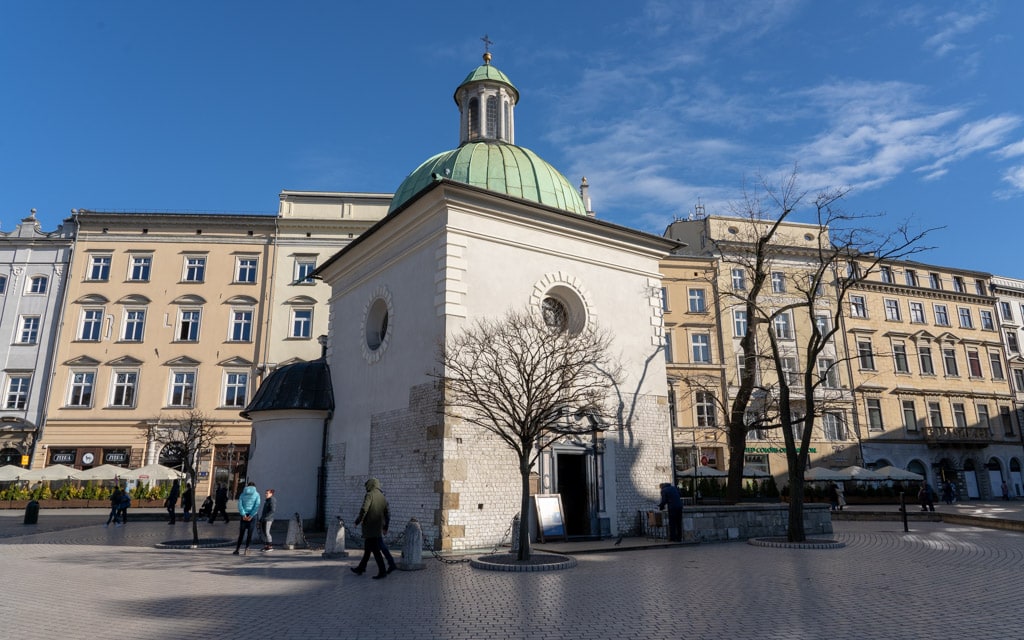
This small, copper-domed church located in the southeast corner of Main Market Square is the Church of St. Adalbert, also known as the Church of St. Wojciech (Kościół św. Wojciecha).
The oldest parts of this church date back to the 11th century, making it one of the oldest stone churches in Poland.
The Church of St. Adalbert predates the Main Market Square. When built, the church aligned east to west, which was customary. So, while the church looks crooked, the square is crooked.
Any other “crooked” building you encounter walking around the Old Town most likely predates the rebuilding of Kraków after its destruction by the Mongols in 1241.
The church’s oldest Romanesque parts date back to the 11th and 12th centuries. Between 1611 and 1618, it was reconstructed in a Baroque style, including the addition of the dome.
If you visit in the summer when the interior is open, peek inside to view the Baroque architecture, which dates back to the 18th century.
10 – Town Hall Tower (Wieża ratuszowa w Krakowie)
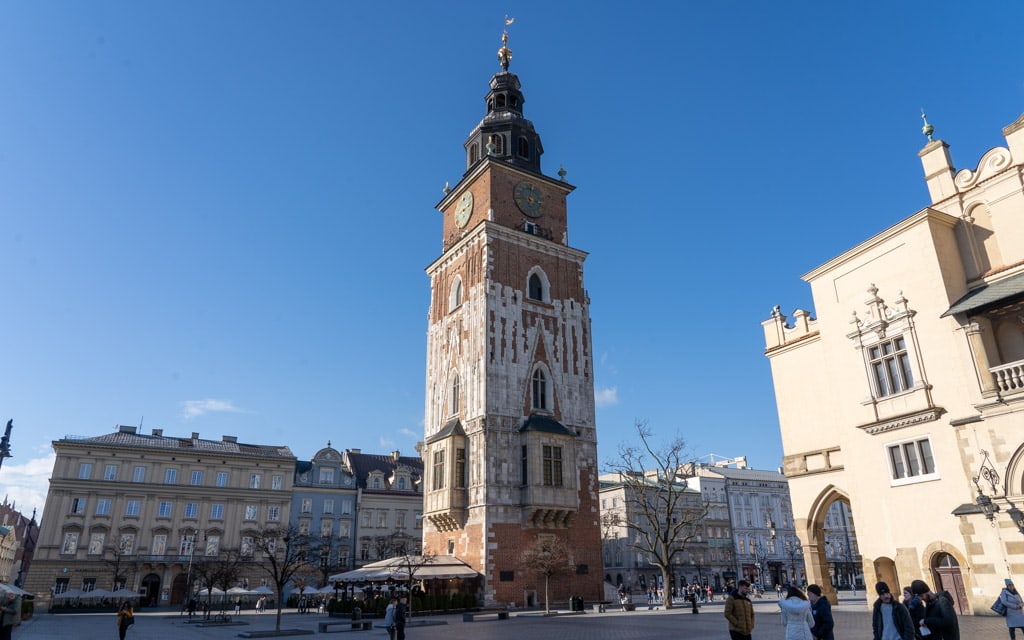
This lonely tower located on the Main Market Square next to the Cloth Market is known as the Town Hall Tower (Wieża ratuszowa w Krakowie). It is all that remains of Kraków’s old Town Hall.
The first Town Hall, built at this location, dates back to 1316. Over the centuries, it expanded and underwent multiple renovations. By the early 19th century, Kraków’s importance had declined, and in 1820, its Town Hall was demolished.
All that remains of the original Town Hall is this 70 meter (229 foot) Gothic tower built of brick and stone.
Visitors to the tower will find a small, unimpressive museum inside. Those who wish to climb to the top will be disappointed in the underwhelming views of the city below.
11 – Eros Bendato Sculpture (The Head)

A hard-to-miss sculpture of a gigantic empty head wrapped in cloth lies near the Town Hall Tower base.
While this well-known Igor Mitoraj sculpture is officially known as Eros Bendato, its nickname is “The Head.”
The sculpture, completed in 1999, was designed by Igor Mitoraj (1944-2014), a Polish contemporary artist and sculptor who studied at the Kraków Academy of Art.
In 2003, Mitoraj gifted the Eros Bendato sculpture to Kraków. The original plan was to place it in the square in front of Galeria Krakowska near Kraków Główny Station, but Mitoraj insisted on putting it on Main Market Square.
Despite protests from locals and historians who claimed the modern sculpture clashed with the old town’s charm, it found a home in the western corner of the square near the Town Hall Tower.
Today, the Eros Bendato sculpture is a popular meeting point and accidental tourist attraction.
During the day, you can usually find children or tourists climbing in and around the hollow head. It makes for a unique photo.
12 – Jagiellonian University (Uniwersytet Jagielloński) and Great College (Collegium Maius)

Founded in 1364 by Kazimierz the Great, Jagiellonian University (Uniwersytet Jagielloński) is the oldest university in Poland and the second oldest university in Central Europe after Charles University in Prague, Czech Republic.
With around 150,000 students, Jagiellonian University plays an essential role in the character of Kraków.
In the area west of Old Town are many university buildings. One of these buildings is Great College (Collegium Maius), the oldest building at Jagiellonian University.
Dating back to the 14th century, Collegium Maius is the historic heart of Kraków’s university culture.
Collegium Maius was rebuilt in the 15th century. The late Gothic structure, with its large courtyard, featured arcades and two levels. In 1517, the well in the center of the courtyard was added.
During the Middle Ages, lectures were held on the lower level while professors lived, worked, slept, and ate on the upper level.
These unmarried professors devoted their entire lives to their profession, similar to monks living at a monastery. In a way, this building resembles a monastery more so than a university.
13 – Bishop’s Palace (Pałac Biskupi w Krakowie)
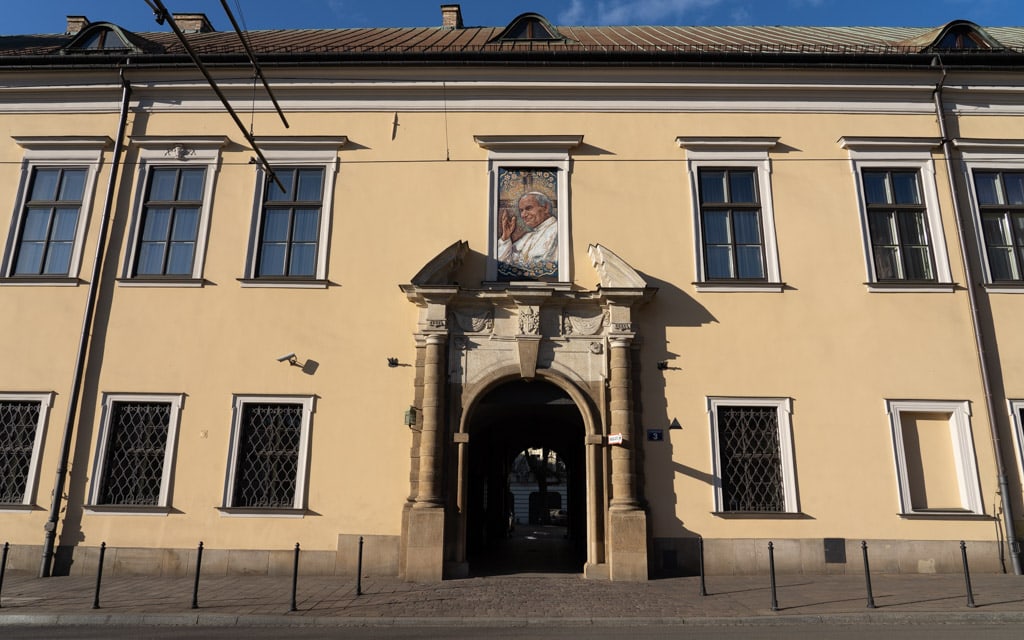
This yellow building is known as the Bishop’s Palace (Pałac Biskupi w Krakowie). It is the second largest palace in Kraków after Wawel Castle.
Since the late 14th century, this palace has been a residence of Kraków’s bishops.
The most famous resident of Bishop’s Palace was Karol Józef Wojtyła, who lived here from 1958 until 1978 when he became Pope John Paul II, head of the Catholic Church.
Even after becoming pope, Pope John Paul II returned to the Bishop’s Palace during his visits to Kraków from Rome.
During these visits, the pope would often appear in the evening in the Papal Window just above the entryway.
Here, the pope addressed his followers, sometimes chatting for hours about various topics, including religion, current events, and sports.
A mosaic image of Pope John Paul II designed by Magdalena Czeska is now on display in the Papal Window.
14 – Basilica of St. Francis of Assisi (Bazylika Franciszkanów w Krakowie)

This Roman Catholic Gothic Church, possibly the most colorful in Kraków, is the Basilica of St. Francis of Assisi (Bazylika Franciszkanów w Krakowie).
The church, located across the street from the Bishop’s Palace, was the home church of Karol Wojtyła when he was archbishop of Kraków. When he returned from Rome for city visits, Pope John Paul II would also visit the church.
The original church, built in the 13th century, was one of the city’s first brick and sandstone buildings. Throughout the centuries, the church expanded until its destruction in 1850 during the Kraków Fire.
Shortly after the fire, members of Young Poland (Młoda Polska), Stanisław Wyspiański, and Józef Mehoffer helped rebuild the church. Thanks to their efforts, the church is now the finest example of Art Nouveau in Poland.
Once inside the church, walk down the nave and find the third pew on the left, where you will find a silver plate labeled “Jan Pawell II.”
This was where Pope John Paul II would come to pray when he lived across the street at the Bishop’s Palace.
Continue a few more feet down the nave and turn around. You are now looking at one of Wyspiański’s finest masterpieces.
This magnificent stained-glass window, inspired by the Sistine Chapel, is titled God the Father Let It Be. As light changes during the day, the yellow and orange, symbolizing fire, changes to blue, symbolizing water.
You can view more of Wyspiański’s stained-glass windows at the Wyspiański Pavilion, described later in this guide.

The small chapel to the left of the nave is a replica of the Shroud of Turin. This replica is a holy relic because it touched the original shroud.
Many believe that the Shroud of Turin was the burial shroud wrapping Jesus of Nazareth after his crucifixion.
15 – Grodzka Street (Ulica Grodzka)

This part of the Royal Way you are currently on is Grodzka Street (Ulica Grodzka), one of the oldest streets in Kraków. Grodzka Street, which passes by many important churches and palaces, is about 650 meters (2,130 feet) long.
The copper-colored building on the corner of Franciszkańska and Grodzka, just behind the Basilica of St. Francis of Assisi, is the Wyspiański Pavilion.
This building displays three stained-glass windows based on Wyspiański’s designs he created for Wawel Cathedral. It’s free to step inside, and you can find the entrance just to the left of the small TI.
These are the rejected stained-glass window designs by Wyspiański, recreated on the 100th anniversary of his death in 2007.
On the left is Saint Stanislaus, the first saint of Poland. A skeleton of Kazimierz the Great, King of Poland from 1333 to 1370, is in the middle. Finally, on the right is Henry the Pious, Duke of Kraków.

Along this lively thoroughfare, you might notice fine arcades on the sidewalks.
While these charming arcades appear to be Renaissance in style, they date back to 1939 after the Nazis invaded Poland. The Germans hoped to elevate the status of their Polish capital by improving the city.
Here, you can also find some of Kraków’s best restaurants and milk bars (bar mleczny).
Milk bars are cheap communist-era cafeterias today and are popular for their affordable yet delicious and hearty Polish food.
Bar Mleczny Pod Temidą, with the blue sign at #45, is the most traditional milk bar you will find on Grodzka Street.
18 – Wawel Cathedral (Katedra Wawelska)

Located on the southern end of Kraków’s Royal Road is Wawel Cathedral (Katedra Wawelska), Poland’s national church.
This Roman Catholic church and cathedral on Wawel Hill has over 900 years of history and has served as the coronation site of many Polish kings.
The cathedral also holds the tombs of many important rulers and historical figures.
The Gothic cathedral as seen today, the third on this site, dates back to the 14th century.
The first cathedral was built and destroyed in the 11th century. The second cathedral was built in the 12th century and destroyed by a fire in the first part of the 14th century.
The cathedral holds the crypts of monarchs, saints, generals, national heroes, poets, and other historical figures. Over the centuries, individual monarchs have extended the cathedral and added new chapels.
You can see the variety of styles inside and outside the church. These styles include 12th-century Romanesque, 14th-century Gothic, 16th-century Renaissance, and 18th-century Neoclassical.
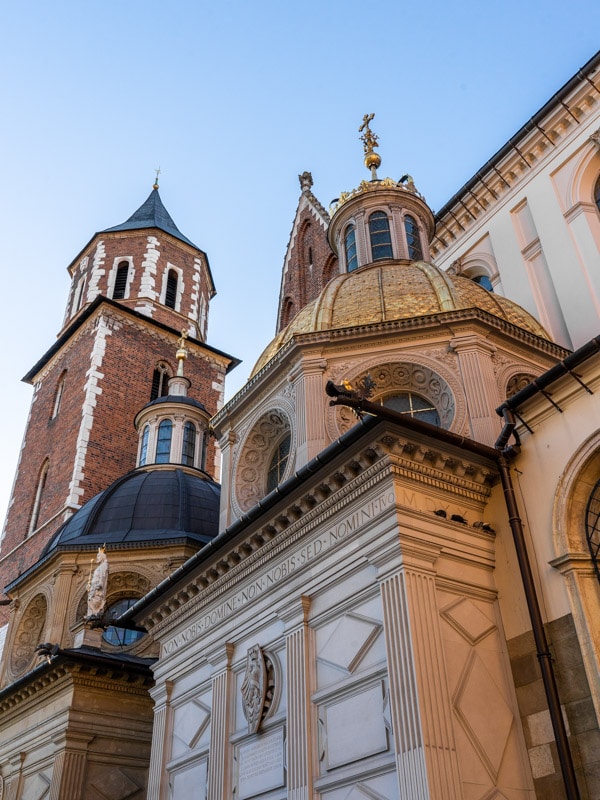
Scan the cathedral’s exterior for the golden dome of Sigismund’s Chapel. This chapel, constructed with 80 pounds of gold, was built between 1517 and 1533.
The chapel holds memorials of Jagiellonian kings, including Sigismund I the Old. During the 16th century, Poland was in a golden period of Renaissance, and Sigismund was responsible for much of this.
16 – Wawel Cathedral (Katedra Wawelska)

Located on the southern end of Kraków’s Royal Road is Wawel Cathedral (Katedra Wawelska), Poland’s national church.
This Roman Catholic church and cathedral on Wawel Hill has over 900 years of history and has served as the coronation site of many Polish kings.
The cathedral also holds the tombs of many important rulers and historical figures.
The Gothic cathedral as seen today, the third on this site, dates back to the 14th century.
The first cathedral was built and destroyed in the 11th century. The second cathedral was built in the 12th century and destroyed by a fire in the first part of the 14th century.
The cathedral holds the crypts of monarchs, saints, generals, national heroes, poets, and other historical figures. Over the centuries, individual monarchs have extended the cathedral and added new chapels.
You can see the variety of styles inside and outside the church. These styles include 12th-century Romanesque, 14th-century Gothic, 16th-century Renaissance, and 18th-century Neoclassical.

Scan the cathedral’s exterior for the golden dome of Sigismund’s Chapel. This chapel, constructed with 80 pounds of gold, was built between 1517 and 1533.
The chapel holds memorials of Jagiellonian kings, including Sigismund I the Old. During the 16th century, Poland was in a golden period of Renaissance, and Sigismund was responsible for much of this.
17 – Kanonicza Street (Ulica Kanonicza)
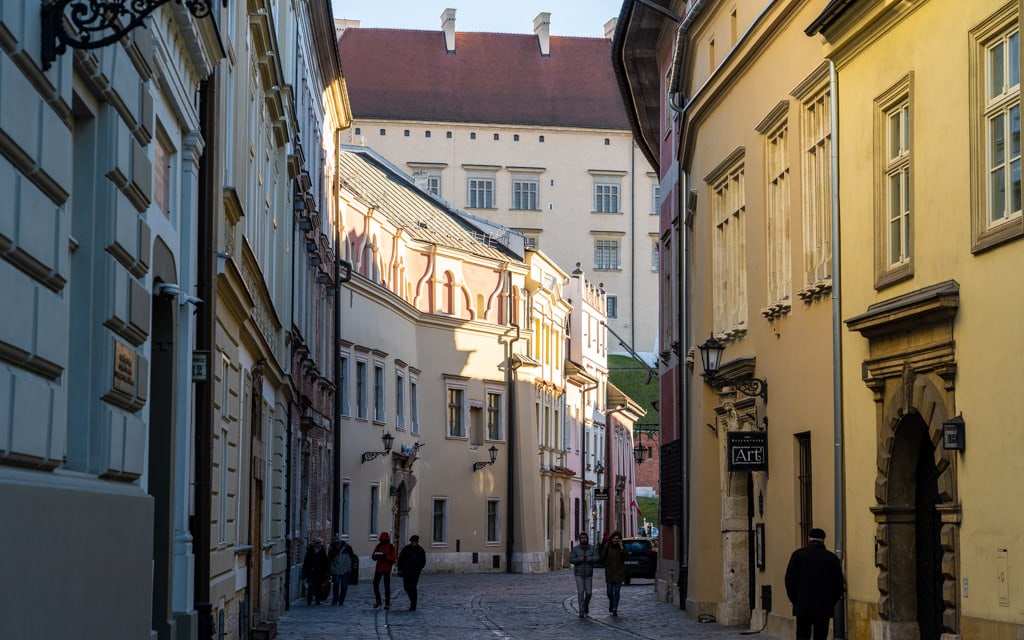
This historic cobbled street leading to Wawel Castle is known as Kanonicza Street (Ulica Kanonicza) or Canon Street, one of Europe’s finest streets. Kanonicza is also the oldest street in Kraków.
This picturesque street, featuring many well-preserved Baroque and Renaissance houses and mansions, was where Kraków’s noblemen lived until the 14th century.
After the 14th century, these buildings housed many of Kraków’s clergy and canons. Look for cardinal hats over the entrances at #3, #15, and #18.
On the left-hand side at #16 is Hotel Copernicus. This hotel, located in a 15th-century building, is famous for hosting guests such as President George W. Bush, the Prince of Wales, and even Copernicus over 500 years ago.
Across the street at #17 is Erazm Ciołek Palace, which houses the National Museum.
The Florian Mokrski Palace, located at #18, was the residence of Florian Mokrsk, Bishop of Kraków, from 1367 to 1380.
The yellow house located at #19 today houses the Archdiocesan Museum. Before becoming Pope John Paul II, Karol Wojtyła lived at this house for ten years after the Second World War.
Bonus: 18 – Mary Magdalene Square (Plac Św. Marii Magdaleny)

This small square located between Grodzka Street and Kanonicza Street is known as Mary Magdalene Square (Plac Św. Marii Magdaleny).
Besides Rome, Kraków has more churches per square kilometer than any other city. Today, there are over 140 churches and monasteries in the city, with 32 alone in the Old Town. You can see two of these from this square.
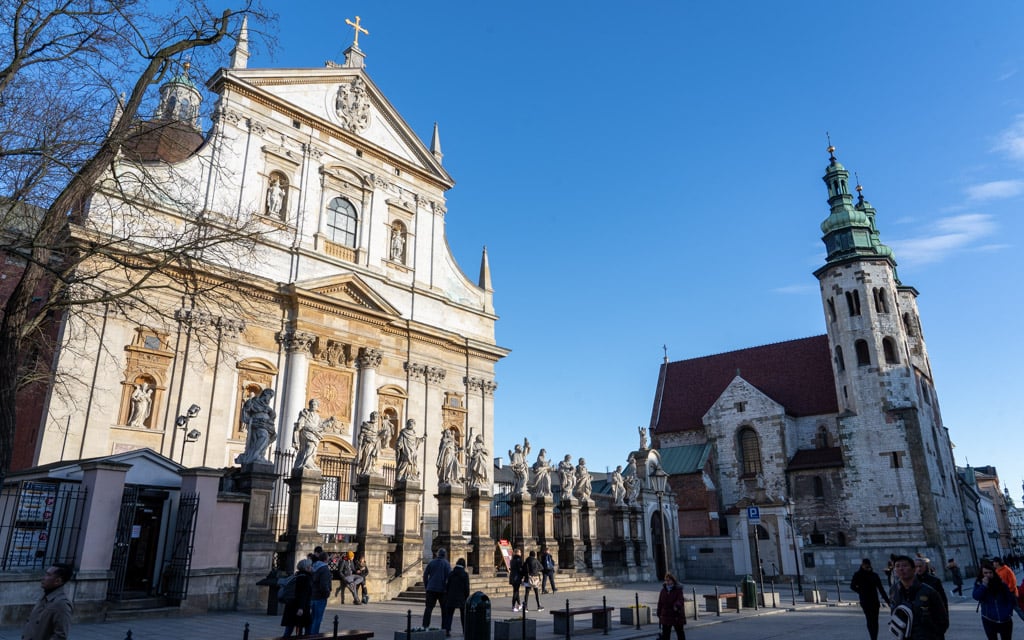
On the left, with the white facade and row of statues out front, is the Church of Saints Peter and Paul (Kościół ŚŚ Piotra i Pawła w Krakowie). Built between 1597 and 1619, this was the first Baroque church in Kraków.
In front of the church are statues of saints and Mary Magdalene, the square’s namesake.
On the right, with its twin towers, is St. Andrew’s Church (Kościół św. Andrzeja). Polish statesman Palatine Sieciech built this Romanesque-style church between 1079 and 1098.
It was the only church to survive the Mongol invasion of Poland between 1240 and 1241.
Last Updated on September 18, 2024
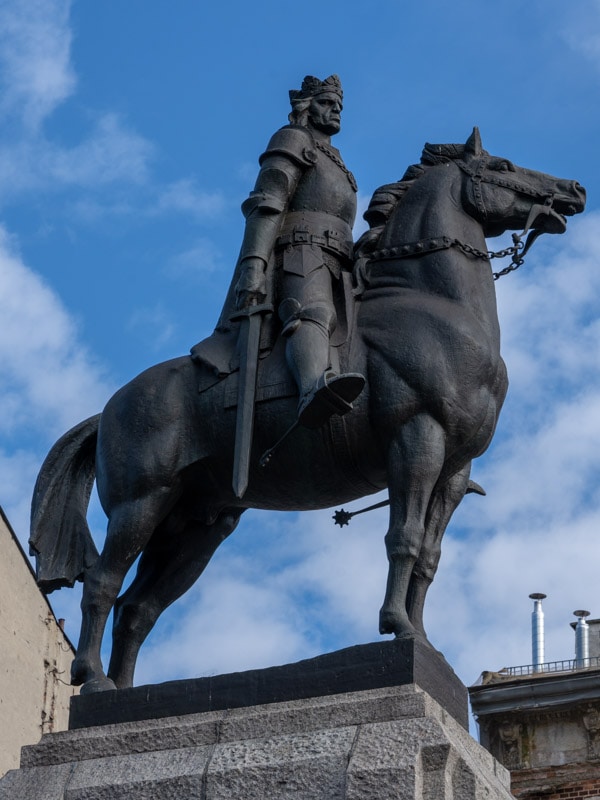
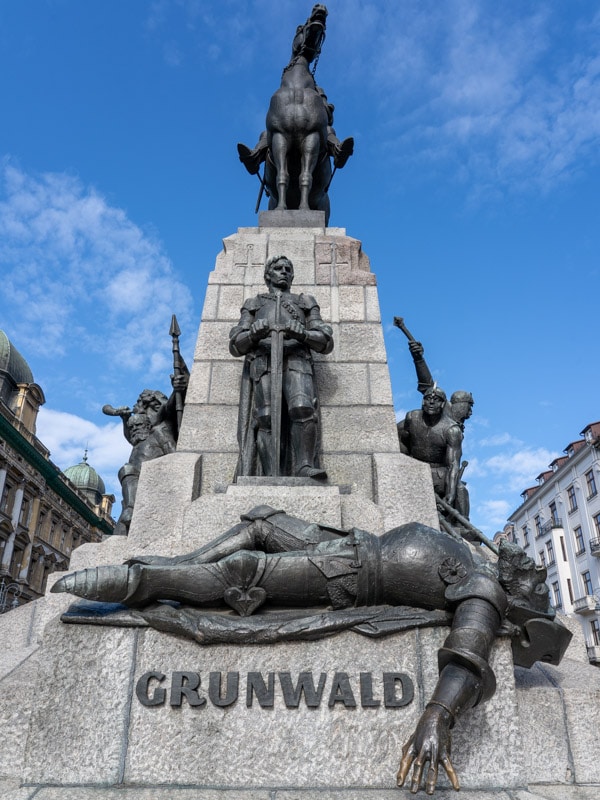

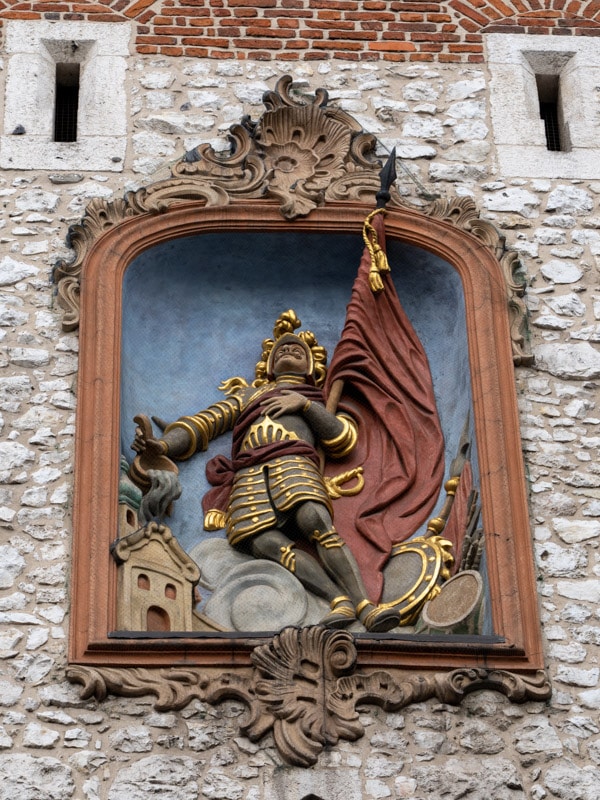
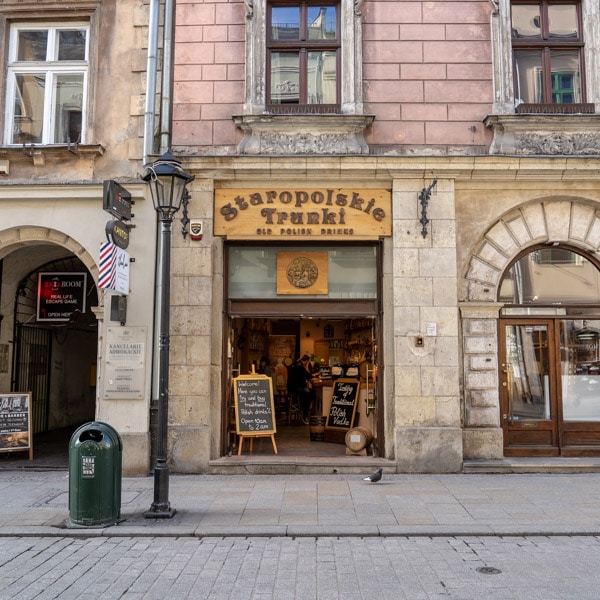


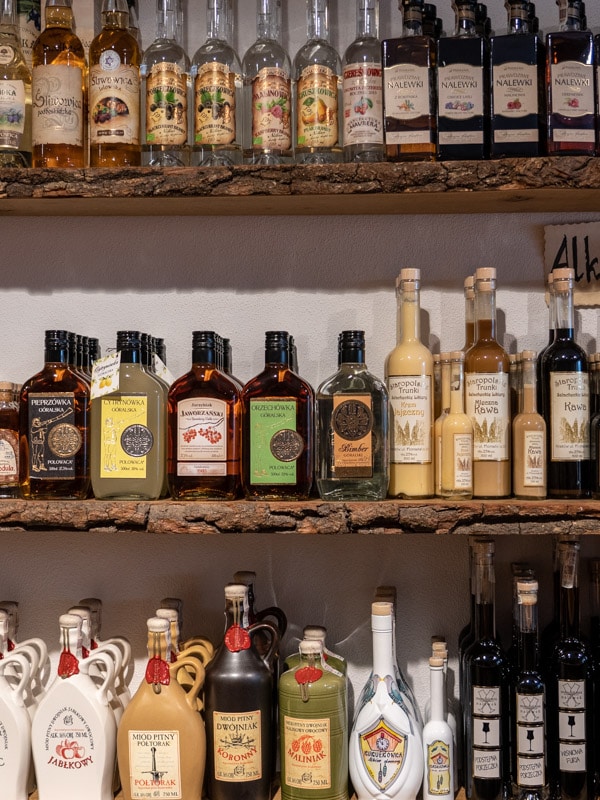

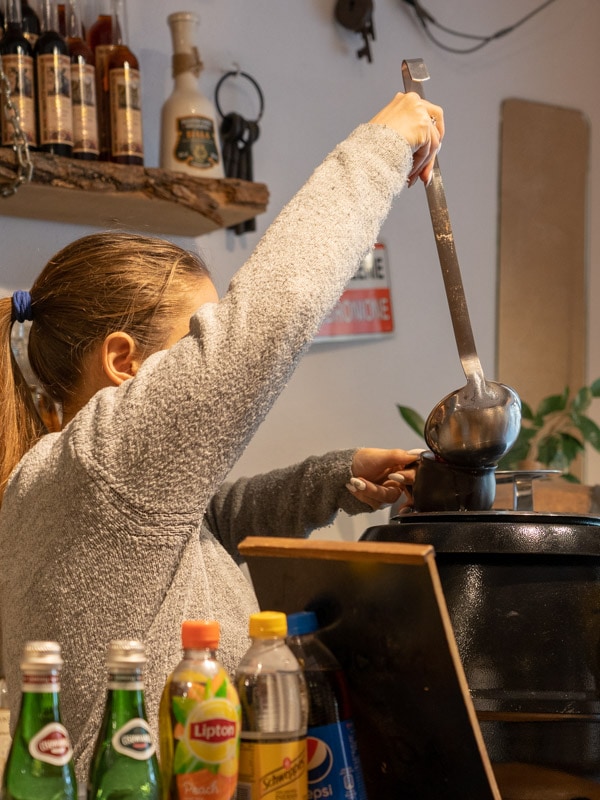



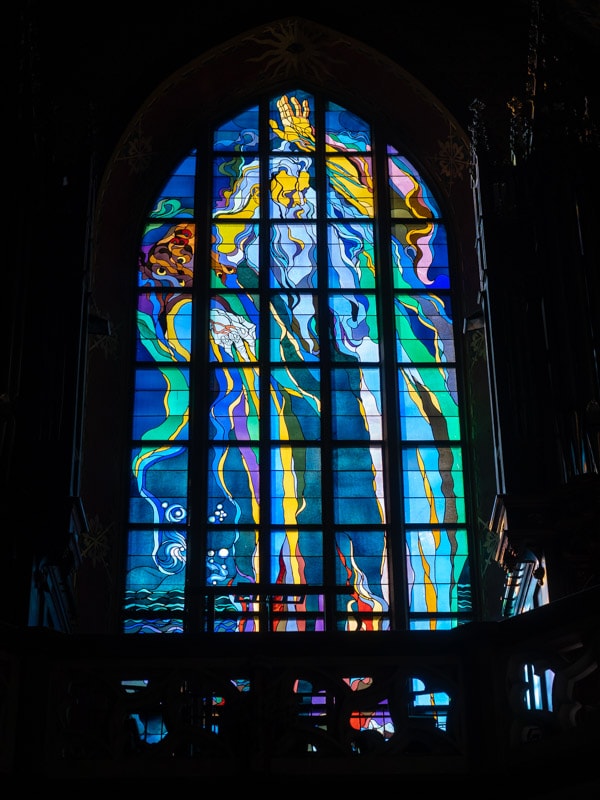
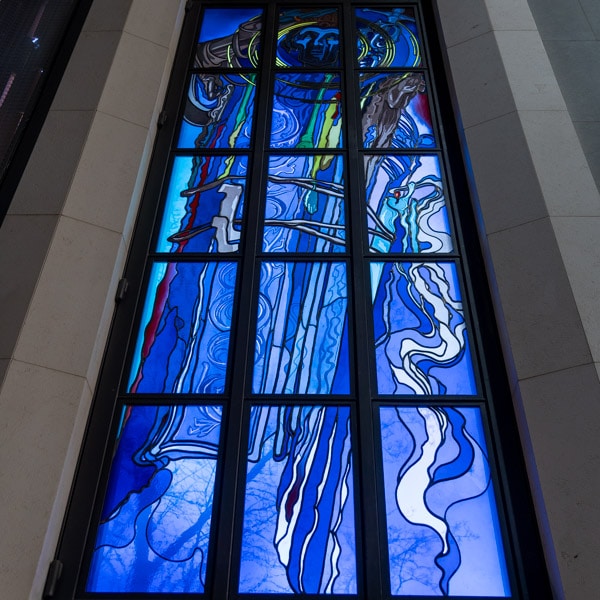






Related Posts